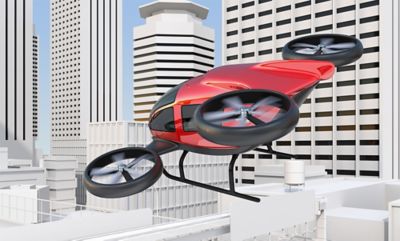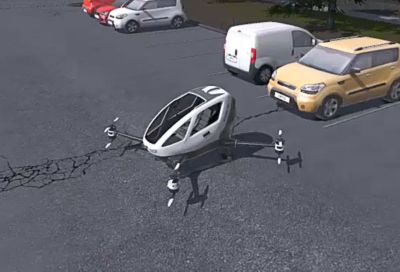ANSYS BLOG
July 03, 2019
Autonomous VTOL Design Requires a Systems Simulation Approach
Engineers are designing autonomous, vertical takeoff and landing (autonomous VTOL) aircraft to accomplish various tasks, including:
- Infrastructure inspections
- Crop dusting
- Urban mobility
- Military operations
Engineers can use the Ansys simulation environment to test and design autonomous VTOL aircraft.
These applications are significant drivers for the development of autonomous aircraft. In fact, autonomous airport shuttles and air taxies alone are estimated to be a $500 billion market.
To tap into this market, engineers need to ensure that autonomous VTOL aircraft can handle every conceivable situation — and transition from vertical to horizontal flight — without human interaction.
Testing the VTOL aircraft for every conceivable situation is impossible using physical testing. Therefore, engineers can test these scenarios, and ensure the safety of their designs, using the Ansys simulation environment. Ansys provides a complete solution that can produce virtual models, operating scenarios, vehicle dynamics simulations, sensor simulations, embedded software and functional safety.
The Tools Engineers Need to Design Autonomous VTOL Aircraft
To understand the physics, embedded software and functional safety of autonomous VTOL aircraft, engineers need to use various engineering software solutions within a systems simulation approach.
First, engineers have to model the fluid dynamics involved with the VTOL’s vertical takeoffs, landings and horizontal flights. This analysis can be done within Ansys Fluent.
Next, engineers will need to simulate the aircraft’s sensors. For optical sensors, like lidar and cameras, engineers can use Ansys Speos. For radar sensors engineers can use Ansys HFSS.
An Ansys simulation of an autonomous VTOL drone taking off in a virtual urban environment. The simulation accounts for the wind, flight dynamics and optical phenomena — like the reflection of sunlight off other objects.
Once engineers have a better understanding of the physics behind VTOL aircraft, they can begin to develop systems simulations and control logic that govern how everything works together. They will also need to ensure the functional safety of the entire system. The systems simulations can be created within Ansys Twin Builder, the control logic can be created using Ansys SCADE and functional safety can be assessed using Ansys medini analyze.
Finally, all the simulations, control logic and functional safety assessments can be tested in virtual reality using Ansys VRXPERIENCE. Virtual reality helps engineers ensure that passengers are comfortable with the look and feel of VTOL flight.
To understand, in more detail, how all these tools are used to develop future aircraft systems, read: Autonomy Takes Flight via Simulation.
To learn of how simulation can help other aerospace and defense projects, download the white paper: Staying Ahead of the Threat: Simulation from the microchip to the mission.

